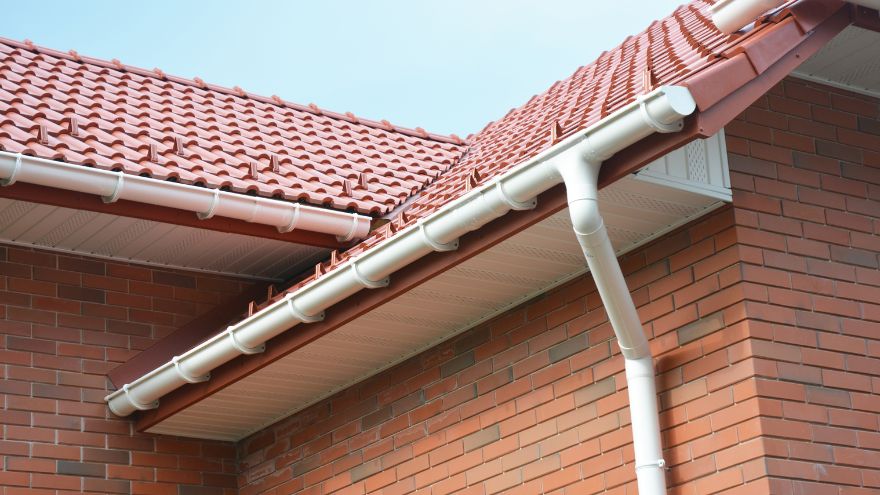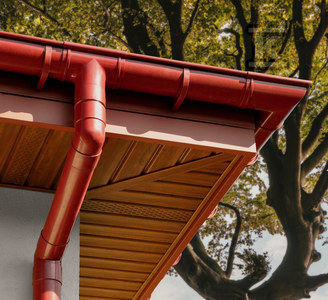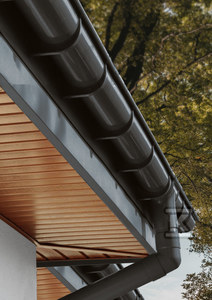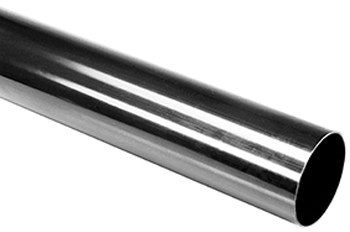Downpipes are used to effectively drain water from the roof surface to the rainwater drainage system or to an absorption well. They are characterized by a simple, solid construction. Do you want to create an efficient and durable gutter system for rainwater drainage? Not sure what shape, material and size of downspout will suit your design needs? Read the guide prepared by Onninen experts.

Check the downpipes at the Onninen wholesaler
What material should the downpipe be made of?
 The downpipe is an element of the rainwater drainage system from building roofs. Thanks to the use of gutters and downpipes, foundations, walls and gardens are better protected against flooding, which helps avoid many costly damages and problems. Various materials are used to produce gutters and downpipes. Plastic models made of polyvinyl chloride (PVC) are especially popular.
The downpipe is an element of the rainwater drainage system from building roofs. Thanks to the use of gutters and downpipes, foundations, walls and gardens are better protected against flooding, which helps avoid many costly damages and problems. Various materials are used to produce gutters and downpipes. Plastic models made of polyvinyl chloride (PVC) are especially popular.
It is an extremely durable and resistant material. PVC downpipes are light, inexpensive and highly resistant to mechanical damage and difficult weather conditions. They do not corrode and do not discolor due to UV radiation. They constitute an aesthetic complement to the facade for a long time. There are various color variants to choose from.
The market also offers gutters and downpipes made of powder-coated aluminum, steel - made of coated steel sheet and copper.
How to choose the diameter of the downpipe?
One of the factors determining the choice of a given gutter system is the size of the roof. To correctly select the size of the gutters and the diameter of the downpipe, you should take into account:
- effective roof area - i.e. the area that requires drainage,
- rainfall intensity in a given location.
As the slope of the roof increases, the effective roof area decreases. This value can be calculated using a special formula:
EPD = (H/2 + W) x L
To perform the calculations, you need to know/measure the height of the roof, the horizontal distance from the corner to the ridge and the length of the roof slope. The diameter of the downpipe determines its throughput, i.e. the surface from which water will be drained. Please remember that using a gutter with a larger diameter necessitates changing the downpipe to a variant with a larger diameter. Otherwise, the water will not be drained fully effectively.
Manufacturers often provide tables that facilitate the selection of downpipes, but they are usually not universal, but dedicated to specific systems. For example, it is assumed that smaller roofs, with an area of up to 50 m2, require the use of downpipes with a diameter of approx. 80 mm and a correspondingly larger gutter - approx. 100 mm. In the case of a large roof of more than 100 m2, the downpipes should not have a diameter less than 110 mm and the gutters should not have a diameter less than 150 mm.
It is best to plan the diameters, as well as the number and arrangement of downpipes and gutters on roofs, together with a professional, e.g. an architect who prepares the drainage design. The specialist will make the necessary calculations and take into account the specificity of the building, in particular the arrangement of windows and balconies.
Check the downpipes at the Onninen wholesaler
Choosing the shape of the downpipe
The options available are:
- round downpipes (the most popular semi-circular gutters fit them),
- square downpipes,
- rectangular downpipes.
The shape of the gutter and downpipe is not only important aesthetically. It can significantly affect the life and performance of the entire gutter system. The downpipe must match the cross-section of the gutter. The cross-section of the downpipe should be equal to 3/4 of the cross-section of the gutter. Specialists sometimes recommend that the drain pipe entries should be cone-shaped.
It is worth remembering that the semi-circular structure of the downpipe makes it easy for various types of contaminants to get into it and stay in it, e.g. mud, sand, leaves, fruit, branches, feathers and animal hair, etc. They can lead to a significant reduction in throughput, and consequently lead to damage to the material. Therefore, you should ensure regular cleaning of the gutter system, especially in the autumn and winter season, when the flowing water tends to freeze.
It is best to consult a professional when selecting downpipes and all other elements of the gutter system. When ordering a gutter system from the Onninen wholesaler, you can count on reliable advice regarding the optimal diameter, shape and number of downpipes.
Downpipes at the Onninen wholesaler
 The online hydraulic wholesaler Onninen offers a wide range of plastic gutters and downspouts as well as accessories necessary for the proper installation of the piping system in various types of buildings. You can order from us, among others: connectors for gutters and downpipes, handles and screws, downspouts, corners, bottoms, elbows, gutter reductions and tees, clamps, cleaners and revisions, and many other products. Our assortment includes solutions from the most respected manufacturers of plastic installation systems, such as Kaczmarek and Wavin . The customer can be sure that the downpipe he receives is a high-quality product, covered by a long-term warranty, resistant to damage and discoloration, light and easy to install.
The online hydraulic wholesaler Onninen offers a wide range of plastic gutters and downspouts as well as accessories necessary for the proper installation of the piping system in various types of buildings. You can order from us, among others: connectors for gutters and downpipes, handles and screws, downspouts, corners, bottoms, elbows, gutter reductions and tees, clamps, cleaners and revisions, and many other products. Our assortment includes solutions from the most respected manufacturers of plastic installation systems, such as Kaczmarek and Wavin . The customer can be sure that the downpipe he receives is a high-quality product, covered by a long-term warranty, resistant to damage and discoloration, light and easy to install.
Still don't know which downpipe will ensure efficient water drainage from your roof? Do you have problems with calculating the effective area or selecting the shape or diameter of downpipes and gutters? Contact us! Onninen experts are here to help you – both in selecting a complete rainwater management system and in purchasing individual products. Are you an installer or do you sell plastic gutters? We will be happy to cooperate! Special conditions and unique benefits await professionals.
